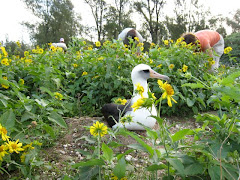Some of the fish hooks were made in two pieces so that if the fish was so strong to take the hook only half of it would break off. For opelu fish hooks were made from shiny shells as they are attracted to that. The kukui tree is a common plant brought by the Polynesians as the nuts are used for lighting. Strung on a midrib the nuts are so oily they burn like mini-torches. Kukui also has the word meaning of “enlightenment.”
 So we as a group spent a good hour using coral and sandpaper to smooth our fishhooks or kukui nuts, then using Kukui nutmeat to oil up our wood and braiding or twisting cordage to make the part that goes around our necks. Each one of us had some success.
So we as a group spent a good hour using coral and sandpaper to smooth our fishhooks or kukui nuts, then using Kukui nutmeat to oil up our wood and braiding or twisting cordage to make the part that goes around our necks. Each one of us had some success.Meanwhile we heard about Maui the demi-god whose fish hook still hangs in the night sky- the constellation of Scorpius, and how his Grandmother told him a chant for his fishhook so that it could catch anything. Then he and his brothers went out fishing and snagged the islands. He told his brothers “Don’t look back!” and “keep paddling, paddle harder!” He was pulling up the Northwest Hawaiian Islands, but then one of the brothers looked back and then the islands couldn’t be pulled up any higher. Stories about Maui are known through out the Pacific. There is one about how he tricked the Alae bird into giving fire to man. On the Waianae side of Oahu there is a silhouette of Maui most visible in the early morning.
And so went that part of our afternoon with arts and culture, storytelling and hands-on activities.
Photo credit: Dani Carter






















